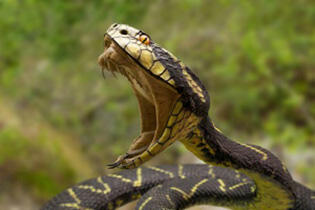
Specialist researchers from LSTM have identified the diverse mechanisms by which variations in venom occur in related snake species and the significant differences in venom pathology that occur as a consequence.
Working with colleagues from Bangor University and Instituto de Biomedicina de Valencia in Spain, the team assessed the venom composition of six related viperid snakes, examining the differences in gene and protein expression that influence venom content. The research, published in PNAS, also assessed how these changes in venom composition impacted upon venom-induced haemorrhage and coagulation pathologies, and how these changes can adversely affect antivenoms used to treat snakebite.
LSTM’s Dr Nicholas Casewell, first author and NERC Research Fellow, said: “Our work shows that venom variation observed between related snake species is the result of a complex interaction between a variety of genetic and postgenomic factors acting on toxin genes. This can involve different genes housed in the genome being turned on or off in different snakes at different stages of venom toxin production. Ultimately, the resulting venom variation results in significant differences in venom-induced pathology and lethality and can undermine the efficacy of antivenom therapies used to treat human snakebite victims.”
Every year, snakebites kill up to 90,000 people, mostly in impoverished, rural tropical areas, as well as causing thousands of debilitating injuries to survivors, in part the reason that snakebite has the status of a neglected tropical disease. Antivenom can work but its efficacy is largely restricted to the snake species used in its manufactures and is often ineffective in treating snakebite by different, even closely related species.
LSTM’s Dr Robert Harrison, senior author of the study and Head of the Alistair Reid Venom Unit, said: “The findings underscore challenges to developing broad-spectrum snakebite treatments, because conventional antivenom is produced by immunising horses or sheep with the venom from a specific species of snake. Consequently, antivenin produced for one species of saw-scaled viper will not necessarily neutralise the venom of another species of saw-scaled viper, highlighting how changes in venom composition can adversely affect snakebite therapy.”
Nicholas R. Casewell, Simon C. Wagstaff, Wolfgang Wüster, Darren A. N. Cook, Fiona M. S. Bolton, Sarah I. King, Davinia Pla, Libia Sanz, Juan J. Calvete, and Robert A. Harrison
Medically important differences in snake venom composition are dictated by distinct postgenomic mechanisms
PNAS 2014 : 1405484111v1-201405484.